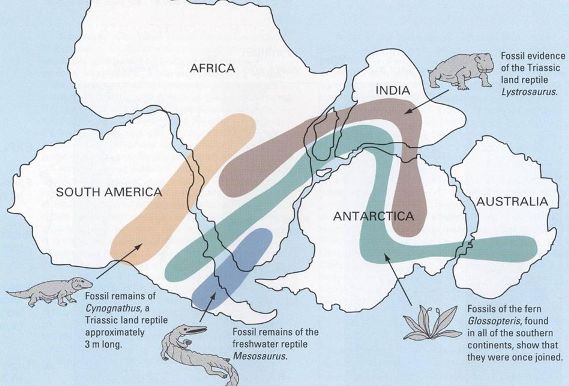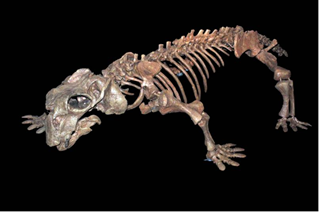Fossil Evidence
There are many examples of fossils found on separate continents and nowhere else, suggesting the continents were once joined. If Continental Drift had not occurred, the alternative explanations would be:
- The species evolved independently on separate continents – contradicting Darwin’s theory of evolution.
- They swam to the other continent/s in breeding pairs to establish a second population.

Image: From This Dynamic Earth: The Story of Plate Tectonics p8
Remains of Mesosaurus, a freshwater crocodile-like reptile that lived during the early Permian (between 286 and 258 million years ago), are found solely in Southern Africa and Eastern South America. It would have been physiologically impossible for Mesosaurus to swim between the continents. This suggests that South America and Africa were joined during the Early Permian.
Cynognathus is an extinct mammal-like reptile. The name literally means ‘dog jaw’. Cynognathus was as large as a modern wolf and lived during the early to mid Triassic period (250 to 240 million years ago). It is found as fossils only in South Africa and South America.

Lystrosaurus
Lystrosaurus - which literally means ‘shovel reptile’ - was dominant on land in the early Triassic, 250 million years ago. It is thought to have been herbivorous and grew to approximately one metre in length, with a stocky build like a pig. Fossils of Lystrosaurus are only found in Antarctica, India and South Africa.
Glossopteris was a woody, seed-bearing shrub or tree, named after the Greek descripton of ‘tongue’ – a description of the shape of the leaves. Some reached 30m tall. It evolved during the Early Permian (299 million years ago) and went on to become the dominant species throughout the period, not becoming extinct until the end of the Permian. Fossils are found in Australia, South Africa,South America, India and Antarctica.
When the continents of the southern hemisphere are re-assembled into the single land mass of Gondwanaland, the distribution of these four fossil types form linear and continuous patterns of distribution across continental boundaries.
Glacial deposits